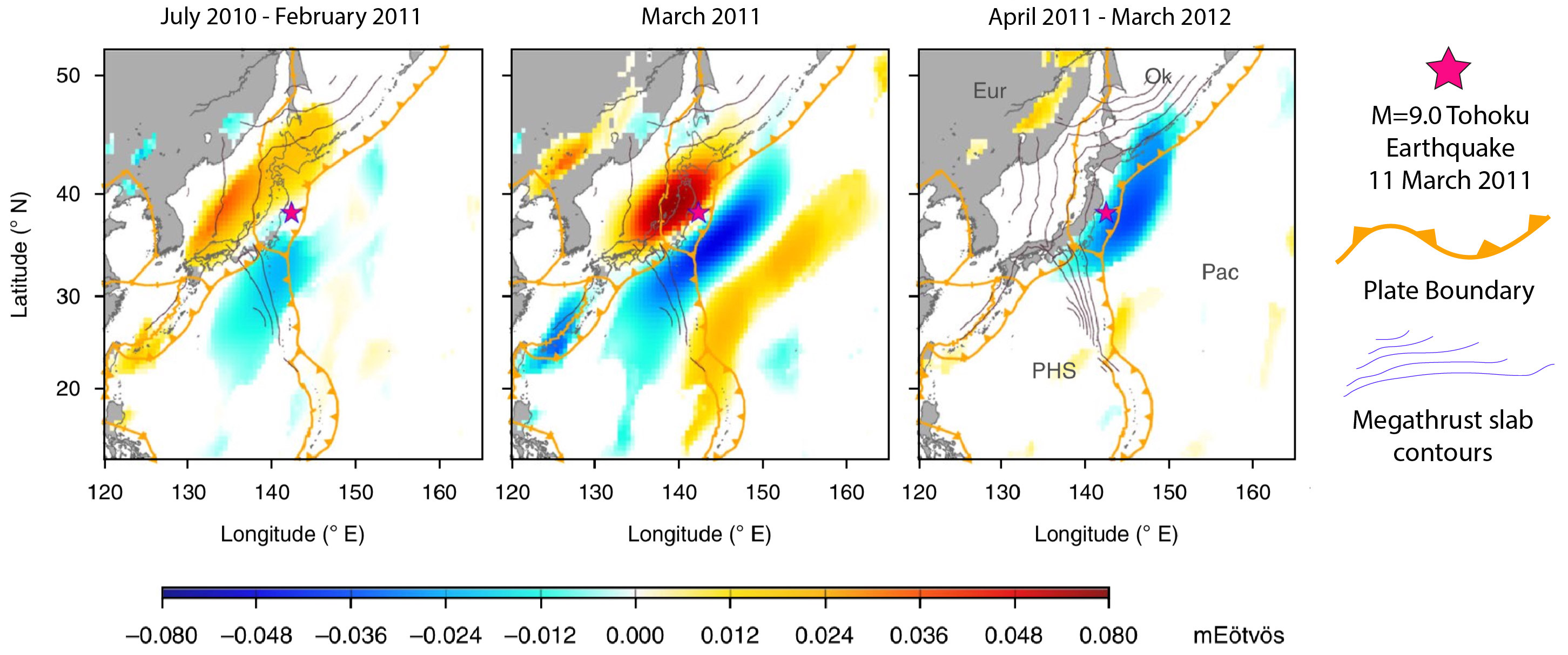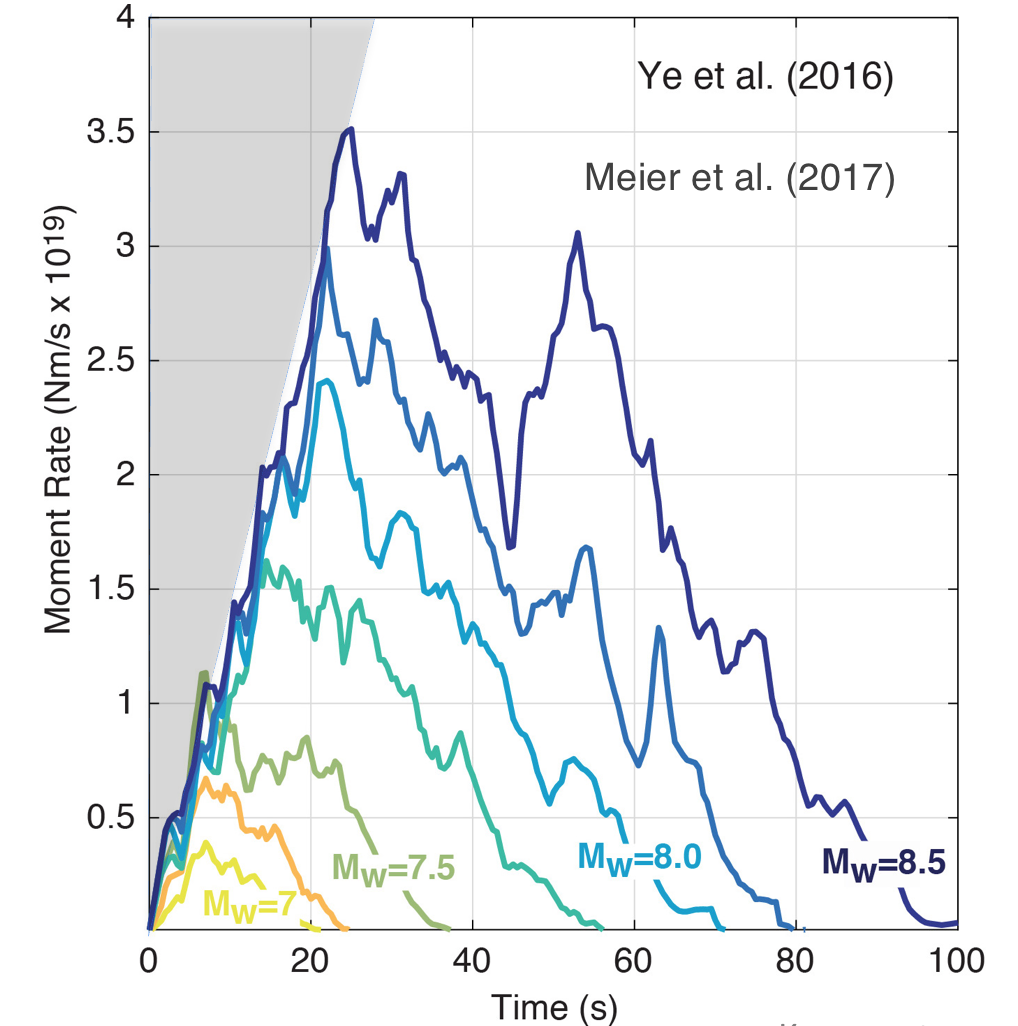By Ross Stein, Ph.D. and David Jacobson, M.Sc., Temblor
Click here to protect yourself from natural disasters

A study by Isabelle Panet and her French colleagues published this month in the high-profile journal, Nature Geoscience, finds a large precursory gravity change over the Japanese archipelago starting a few months before the M=9.0 Tohoku earthquake. The signals were processed from the GRACE (Gravity Recovery and Climate Experiment) satellite duo, launched in 2002. The authors found nothing comparable to the precursory signal in the preceding seven years. They also found a large gravity signal associated with the Tohoku earthquake itself, and with the post-seismic period, as others have previously published, using the same data – exceeding in size, in March 2011, the previously known GRACE signals. Because of its uniqueness and importance, the Panet et al. analysis was subjected to substantial, protracted, and skeptical review, and so was exhaustively tested, and modeled. Its publication does not mean that it’s right, but that it has not been proven wrong.

Now come four critical ‘If’s
If the result is reproducible by others; if a similar precursory signal is found for at least some other megathrusts events, such as the 2004 M=9.2 Sumatra, 2010 M=8.8 Maule, Chile, or 2005 M=8.6 Nias–Simeulue, Indonesia, earthquakes; if no similar signal is seen where large quakes do not follow; and if the GRACE data could be processed in near-realtime to monitor and search for such anomalies before great quakes strike—then this could truly be a breakthrough. That is an exceedingly high bar, one that virtually no other earthquake prediction scheme has ever been able to hurdle. But it is not impossible, and when one considers the death toll tusnamis, and to a lesser extent, shaking, from these goliaths extract, it would be a breakthrough.
What is being measured here?
A megathrust earthquake slips a gently inclined fault by 20-60 m (70-200 feet) over a very wide zone that can be hundreds to almost a thousand kilometers long, and hundreds of kilometers wide. This occurs where an oceanic plate is thrust under a continent or island arc in a process geologists call ‘subduction.’ In the earthquake, the crust of the earth is suddenly thickened or ‘stacked’ offshore, and so locally the mass increases. If you were to weigh yourself offshore Tohoku before and after the M=9, you’d weigh a bit more after the quake, because your weight is the product of your mass and the mass of the sliver of earth beneath you, which is now greater. Onshore, the crust is thinned and stretched, and so you would weigh less. The GRACE satellites detect mass redistributions within the Earth and its fluid envelopes by sensing the associated changes in the gravitational field.

What could go wrong with these observations?
Apart from this study, the best evidence suggests that great earthquakes nucleate and rupture just like small ones, but for unknown reasons, the big ones just keep rupturing. The speed at which the rupture grows is almost the same for a M=7 and M=9 quake, the only difference being that the M=7 starts to peter out after about 10 seconds, and for a M=9, event this may not begin until 60 seconds or more. For Panet et al. to be right, this view of rupture process must be wrong, because there would be preconditions that promote the occurrence of a much larger event; some events would know they are going to be great.

There is an enormous amount of signal processing to reach these results, some of which is tuned to the orientation and scale of the subduction zone. This is why reproduction of their results by independent investigators is so important. The Asian monsoon rains add mass to the Earth’s surface, as does the shrinking and growing of snow and ice. Storms and currents alter the mass of the ocean offshore. All of these signals can last months, and so must be fully removed. But while there is a remaining monsoon signal in eastern China in the Panet et al. results in their August 2010 and February 2011 maps, these are smaller and more isolated than the precursory anomaly, which persists over time. When Panet et al. stacked all of the signals over 2006-2009, no anomaly as large as the precursory feature is seen. And when they look at a huge area centered on the anomaly during 2011, this one feature stands out by its size and intensity.

If real, what is the cause of the anomaly?
The authors argue that the descending slab extended or stretched in the earth’s mantle. If the source of the precursory mass change is hundreds of kilometers deeper than the eventual earthquake rupture, and if it is not too localized, it would explain why the anomaly is even broader than the co-seismic signal. Further, the source would have to be very deep for the deformation to have evaded detection by Japan’s unmatched GPS monitoring network. There is a subtle GPS excursion before the Tohoku quake (Mavrommatis et al. 2014), but it took about a decade to occur and so would seem to be unrelated.
What next?
In short order—perhaps a year—we will know if this fizzles, or is the beginning in a new chapter in our understanding of great quakes, and possibly, a new seismic sentinel to protect the public. The chances of that are small, but that is what science is for, and that is what makes it exciting.

References
Mavrommatis, A. P., P. Segall, and K. M. Johnson (2014), A decadal-scale deformation transient prior to the 2011 Mw9.0 Tohoku-oki earthquake, Geophys. Res. Lett., 41, 4486–4494, doi:10.1002/2014GL060139.
M.-A. Meier, J. P. Ampuero, T. H. Heaton, The hidden simplicity of subduction megathrust earthquakes, Science 357, 1277–1281 (2017) 22 September 2017
Isabelle Panet, Sylvain Bonvalot, Clément Narteau, Dominique Remy and Jean-Michel Lemoine, Migrating pattern of deformation prior to the Tohoku-Oki earthquake revealed by GRACE data, Nature Geoscience | VOL 11 | MAY 2018 | 367–373
- Upgrading Tsunami Warning Systems for Faster and More Accurate Alerts - September 26, 2025
- April 2025 magnitude 6.2 earthquake near Istanbul highlights strengths and weaknesses in seismic mitigation - September 14, 2025
- 2025 Kamchatka tsunami triggered rapid insurance payout in the South Pacific - September 12, 2025
